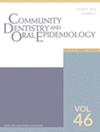To investigate whether timing, accumulation and trajectories of poverty are associated with dental caries in young adolescents.
The study was conducted within the Generation R Study, which is an ongoing population-based prospective cohort study conducted in Rotterdam, the Netherlands. This study included 2653 children. Information about household income and number of children and adults living in a household at six time points from pregnancy to 13 years old was retrieved from parental questionnaires to construct the poverty variable. Dental caries was assessed with the decayed, missing and filled teeth index through intraoral photographs at the age of 13 years. Sociodemographic and oral health-related characteristics were included as possible confounders. The association between poverty and dental caries was analysed on the basis of the three lifecourse theories, that is, critical period, cumulative risk and social mobility model. For the latter, we used latent class growth analysis (LCGA) to identify poverty trajectories over time. Next, the associations were studied with Hurdle Negative Binomial Models.
Poverty at birth and intermittent poverty up to the age of 13 were significantly associated with dental caries at 13 years of age (OR 1.41, 95% CI 1.01–1.99; OR 1.36, 95% CI 1.01–1.83 respectively) and with an increased mean number of decayed teeth by 34% (95% CI 1.02–1.76; 95% CI 1.05–1.71, respectively). LCGA showed four trajectories for the probabilities of poverty. All trajectories were significantly associated with dental caries at 13 years of age, with the ‘downward mobility’ trajectory showing the strongest association with dental caries (OR 1.55, 95% CI 1.05–2.29) and an increasing mean number of decayed teeth by 58% (95% CI 1.18–2.12) than the ‘stable absent’ trajectory.
Poverty at birth, intermittent poverty and downward poverty trajectory were associated with higher odds and higher mean number of decayed teeth at 13 years of age. The three lifecourse models influenced dental caries status during adolescence, hence strategies and policies targeted to improve socioeconomic conditions on deprived children should be implemented.



